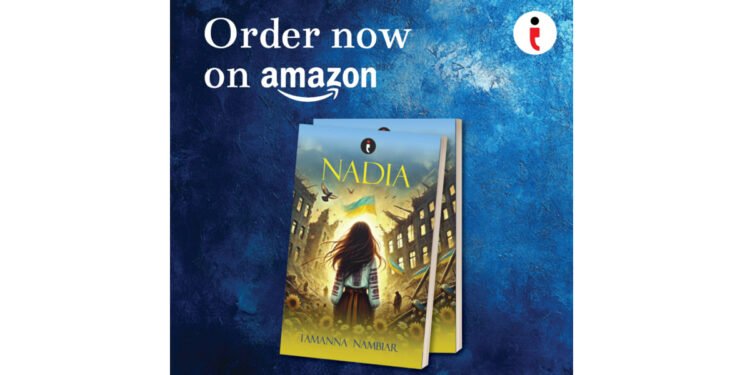Voice of a Generation: Tamanna Nambiar
Tamanna Nambiar is a keen, inquisitive voice for her generation, studying at Harrow International School in Bangalore. Passionate about politics, international relations, and global policy, she is captivated by the dynamics of power—who holds it and how it’s exercised. For Tamanna, politics is more than a subject; it’s how she makes sense of the world.
Whether examining policy shifts, global conflicts, or social justice, she digs deeper to uncover the bigger picture. Writing allows her to explore how empathy and policy intersect in a rapidly changing world. With a heart for meaningful political change, she believes that true leadership requires both critical thinking and compassion.
A Story That Stays With You: Nadia
Nadia is a poignant tale of love, loss, and the quiet strength required to rebuild a life.
Nadia, a hopeful young girl, navigates adolescence with a heart full of optimism, cherishing deep connections and dreaming of a bright future. But when war devastates her city, her world is torn apart—her home reduced to rubble, and she is separated from her mother.
In the midst of unimaginable loss, Nadia’s resilience and determination to start a new shine through. Nadia is a story of courage and survival, highlighting the power of human connection and the unbreakable spirit of a young girl facing the harshest realities. It’s a gripping journey of self-discovery, hope, and the will to persevere.
What Inspired the Book
“I wrote Nadia because I wanted young readers to feel seen and understood—even when they’re dealing with big emotions like fear or loss.”
— Tamanna Nambiar
What motivated you to write Nadia?
I was deeply moved by the resilience of the Ukrainian people in the face of war. As I followed the Russia-Ukraine conflict, I realized that beyond the political narratives and news reports, there were stories of ordinary people whose lives were completely upended. I wanted to capture that human experience—the fear, the loss, the survival, but most importantly, the hope.
You’ve dedicated Nadia to the people of Ukraine. How did their resilience influence the story?
Absolutely. The courage of Ukrainians, from civilians to soldiers, and their ability to resist against overwhelming odds was inspiring. Even in their darkest moments, they fought to protect their families, preserve their culture, and maintain their identity. That strength is reflected in Nadia’s journey—her world is torn apart, but she keeps moving forward, finding small acts of kindness and resilience in unexpected places.
Why did you choose to write for a younger audience, and how do you approach crafting a story for them?
Honestly, I think stories have the power to shape how we see the world—especially when we’re young. I wrote Nadia because I wanted younger readers to feel seen and understood, even when they’re dealing with big emotions like fear or loss. I tried to approach the story with empathy and honesty, creating a character who’s hopeful but also going through something hard. I wanted kids to read her story and think, “I’m not alone.”
Children’s books often convey important messages. What themes or values did you focus on in Nadia?
The biggest themes in Nadia are resilience, kindness, and the power of holding onto hope—even when the world feels like it’s falling apart. I wanted to show that strength doesn’t always look loud or brave in obvious ways. Sometimes, it’s just getting up again, choosing love when it’s easier to shut down, or believing in the possibility of a better future.
How do you balance entertainment and education in your children’s books?
For me, it’s all about telling a good story first. If a child connects with the characters, they naturally absorb the more profound messages. I didn’t want Nadia to feel like a lesson—I wanted it to feel like an adventure, like stepping into someone else’s shoes. The education part comes quietly, through emotion and empathy.
Your characters are relatable and charming. How do you create characters that children can identify with, and do they draw from your own childhood?
Nadia definitely has a lot of my younger self in her—her curiosity, her imagination, and her deep need for connection. I also tried to write her as someone real, not perfect. Kids don’t need perfect heroes; they need ones who mess up, who feel scared or uncertain, and who still keep going. That’s what makes a character relatable, I think.
With various entertainment options available for children today, what role do you think children’s books play in fostering a love for reading and storytelling?
Books give us something that screens can’t—they make space for imagination. When you read, you’re creating the world in your mind. That’s so powerful. I think children’s books still matter so much, especially when they’re shared—like when a parent reads aloud or a teacher reads to the class. That’s where the love of storytelling starts.
Children’s books often feature distinct writing styles. How do you write in a way that engages young readers while maintaining sophistication?
I tried to write in a way that felt natural—simple but not simplified. I think young readers can handle emotional depth and beautiful language as long as it feels honest. I used metaphors and imagery but also ensured the story moved quickly and had emotional clarity. Kids grow into their books, and I wanted Nadia to be a book that grows with them, too.
Family and educators play an important role in introducing children to books. How do you envision Nadia being used in educational settings or as part of family reading routines?
I’d love for Nadia to be read together—between parents and kids or in classrooms. It’s the kind of story that opens up conversations about empathy, war, hope, and courage in a way that’s gentle but real. I think it could be used to help children understand big, difficult topics in a human, emotional way. Hopefully, it will also remind them of how powerful their voices and stories can be.
From Scribbles to Spotlight: Tamanna Nambiar’s Storytelling Journey
Tamanna has always had a heart for writing. Long before Nadia was even an idea, she was already filling notebooks with stories during primary school—tales about magical forests, mysterious doorways, and brave girls with big dreams. Some of those early scribbles even won her awards, but more than anything, they lit a spark—a quiet, steady glow that told her storytelling was something she was meant to do.
As she grew older, Tamanna nurtured that spark with care. She took lessons in fiction writing, exploring character arcs, imagery, and emotional pacing. She continued to write—random pieces, half-finished stories, even fragments of dialogue—and every time her words were read aloud or graded, it deepened her sense that writing wasn’t just a hobby. It was part of who she was.
That spark grew into something much bigger during her teenage years when she began to look beyond the world of fairy tales and into the lives of people often overlooked. The seed for Nadia was planted not from textbooks or news stories but from a desire to show what war feels like through a child’s eyes. She wanted to write a story that didn’t just inform—it moved. One that honoured the quiet resilience, hope, and heartbreak of growing up too soon.
She began writing Nadia a couple of years ago, in the margins of her notebook and in the silence of late evenings. It was more than just a story. It was a promise—to herself and to the young readers she hoped would see themselves in Nadia’s journey.
“I wrote Nadia for the child who sees too much but says too little. For the ones who feel things deeply and dream even when the sky goes dark.” — Tamanna Nambiar
Tamanna’s journey is just beginning. But already, she has proven that age is no barrier to empathy and that some stories are too important to wait. Nadia is a testament to the power of storytelling, of resilience, and of young voices that deserve to be heard.
Grab your copy today on Amazon and join Nadia on her powerful journey to rebuild her life, overcoming every obstacle in her path.

















